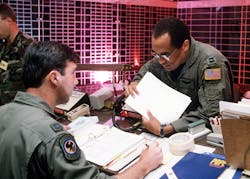Air Force picks two companies to develop mission planning autonomy to facilitate manned-unmanned teaming
WRIGHT-PATTERSON AFB, Ohio – U.S. Air Force researchers are looking to two companies to develop enabling technologies to help automate air force missions from the planning stages to post-mission analysis.
Officials of the Air Force Research Laboratory at Wright-Patterson Air Force Base, Ohio, have awarded contracts to Systems & Technology Research LLC Woburn Mass.; and to RBR Technologies in Odenton Md., for the Science and Technology for Autonomous Teammates (STAT) program.
The STAT program seeks to develop and demonstrate machine autonomy technologies for multi-domain command and control; intelligence, surveillance, recognizance, and processing exploitation, and dissemination; and manned/unmanned combat teaming through human-machine teaming and autonomous decision making.
Systems & Technology Research won an $8.9 million contract on 17 Aug. 2021, and RBR Technologies won an $8.3 million contract on 9 July 2021 for the STAT program.
Related: Artificial intelligence (AI) in unmanned vehicles
This project should result in technology demonstrations that could improve the Air Force's capability to conduct missions in different environments while minimizing the risks to airmen, and enable the Air Force to operate inside of the enemy’s decision loop, researchers say.
STAT will develop and apply autonomy technologies to enhance mission planning, mission execution, and post-mission analysis. The project emphasizes multi-domain command and control, manned-unmanned teaming, and information analytics.
This effort will demonstrate modular, transferable, open-systems autonomy architectures with software algorithms that will ingest and understand mission taskings and commander’s intent; respond appropriately to human direction and orders; and respond intelligently to dynamic threats and unplanned events.
Related: Artificial intelligence and machine learning for unmanned vehicles
Technologies will enable airman-machine teaming to reduce workloads without compromising mission effectiveness or deadlines; enable autonomous systems to understand a commander’s mission requirements and adapt to changing circumstances; and enable autonomous and unmanned systems to integrate safely and efficiently into Air Force operations.
The STAT project revolves around eight research areas: mission planning and debrief; flight operations; communications and datalinks; human interfaces; multi-domain mission operations; executive functions; systems integration; and test and evaluation.
For more information contact Systems & Technology Research online at www.str.us, RBR Technologies at www.rbr-technologies.com, or the Air Force Research Laboratory at www.afrl.af.mil.
About the Author
John Keller
Editor-in-Chief
John Keller is the Editor-in-Chief, Military & Aerospace Electronics Magazine--provides extensive coverage and analysis of enabling electronics and optoelectronic technologies in military, space and commercial aviation applications. John has been a member of the Military & Aerospace Electronics staff since 1989 and chief editor since 1995.
